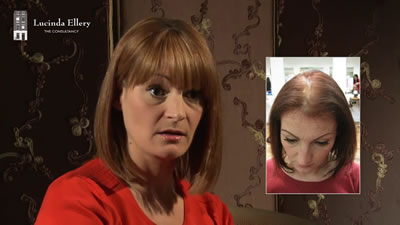Other Hair Loss Treatments Surveyed
Our own techniques are not strictly "treatments" - rather they are methods of disguising and concealing hair loss in women. They can be found on our Intralace pages and our Medi Connect pages.
However we are often asked about other treatments by clients who hope there are ways of curing or reversing their hair loss, so this page is a survey of many of those treatments.
Any search of the Internet offers up dozens of possible treatments for hair loss, but finding one that actually has any benefit and is the right one for you can prove a very expensive and soul-destroying experience. Many treatments simply don't work, while others may only work for a tiny percentage of sufferers. Some are only suitable for men.
Careful research is vitally important if you're considering any of these, as there are very few treatments that are both scientifically proven and licensed to work on the majority of those affected.
Here are some of the treatments that are often promoted elsewhere for hair loss.
We do not offer any of these treatments and most of them would not be suitable for the majority of the clients we see.
We list them here in order to provide information for those wishing to understand what may or may not be suitable for them and for that reason we've included some treatments that are often mentioned in articles but are actually only for men.
Minoxidil – Unisex Hair Loss Treatment
Minoxidil has been widely tested for the treatment for hair loss and is pretty well-known. Although the medication was originally developed to treat high blood pressure, it was later discovered that it had a side effect of stimulating hair growth.
Research at Bradford University has only in the last few years begun to analyse why minoxidil is effective, but despite its actual workings not being clear yet, we do know that minoxidil causes hair re-growth in a small percentage of men and women. More importantly, it also slows down the rate of hair loss. Research has shown that there is an 80% chance of slowing down or sometimes halting hair loss in both sexes.
Minoxidil comes as a lotion and should ideally be applied twice daily to a clean and dry scalp. Other than an occasional allergic reaction or skin dryness, the medication has been found to be free of side effects. Meanwhile, a Minoxidil foam designed for men, Rogaine, may be easier to apply and cause fewer side effects.
In general, 2% strength is recommended for women, while 5% strength is advised for men.
Despite its clear benefits, these will be lost within a few months of stopping use of minoxidil.
Finasteride (Propecia® or Proscar®) - Men Only Hair Loss Treatment
Finasteride is a treatment for men that is taken orally in tablet form. It was originally, and still is, used for the treatment of enlarged prostate glands (prostatic hyperplasia). Although you might not think it, the mechanics are similar to those of the scalp.
Scientists found that Finasteride blocks the conversion of testosterone to dihydrotestosterone (DHT), lowering its level in the bloodstream. Subsequent studies showed that there is an 80% to 90% chance of slowing down or even halting hair being lost through male pattern baldness. Research also showed that there is a 15-30% chance of a significant increase in hair volume. The effects of taking Finasteride normally become apparent after around six months, although any benefits gained from it cease a few months after stopping using it.
As this drug is taken orally, there can be a few side effects, which affect DHT throughout the body and not just on the scalp. The most common side effects are sexual, and affect around one in 200 people. These can include a decreased libido or difficulty in getting or maintaining erections. However, normal sexual function should return within two weeks of stopping the treatment.
As this is a prescription-only medication, men using it will need to see their GP to discuss the benefits and possible side effects, and whether it is appropriate for them.
It should also be noted that the drug must not come into direct contact with a woman who has the potential to get pregnant.
Dutasteride (Avodart®) - Men Only Hair Loss Treatment
Dutasteride works in a similar way to Finasteride, but it is more powerful. To date, it is only licensed for the treatment of enlarged prostates, and not for hair loss. However, research has shown that it is more effective than Finasteride in tackling hair loss, although its potential side effects are more common. These should also be discussed with a doctor.
It should also be noted that the drug must not come into direct contact with a woman who has the potential to get pregnant.
Hair Transplant Surgery – Unisex Treatment, but more useful for men
When performed correctly, hair transplant surgery can sometime produce good results, however It is more commonly performed on men, as the likely level of hair density improvement may be more in line with men's expectations.
In cases where women have thinning or diffuse hair loss the hair that would normally be transplanted is often finer than it would be in men, and thus the process is unlikely to produce much if any improvement in volume, which is usually what women require.
There are some cases where it can be useful for women - for instance hair loss at the temple area is suitable for transplants - but if the loss is at the top of the head then the potential increase in density is limited.
Ultra-refined Follicular Unit Transplantation
A related transplant option is Ultra-Refined Follicular Unit Transplantation, which uses stereoscopic dissecting microscopes, and involves taking hair roots from a 'donor' area at the back or sides of the scalp, where the hair generally continues to grow for your entire life, and relocating them to the bald or thinning areas.
This technique can even be used to restore lost facial hair - including eyebrows, eyelashes, side burns, beards, moustaches and pubic hair.
While it does seem to offer some hope of disguising problems at the hair line it is again more suitable for typical men's hair loss rather than women's.
We've seen some suggestions that this technique can be used on scar tissue, however this is very unusual and the most common form of scarring that we see is the result of Frontal Fibrosing Alopecia, which would be extremely unlikely to respond to any form of transplant.
Litfulo - Alopecia Areata drug treatment
A new drug called Litfulo has been produced by Pfizer to treat Alopecia Areata and was approved for use in the UK in late 2023 by the Medicines and Healthcare products Regulatory Agency (MHRA) in patients of 12 years old and upwards. The US and Canadian health authorities have also approved it.
It targets what are called the JAK pathways of the immune system, which are known to play a part in the processes which stop hair follicles from growing.
Clinical studies have been very promising and this drug is one of the very few to show positive effects.
However the downside is that it's very expensive - costs in the US are suggested to be around $49,000 for a one-year supply.
There are also possible side-effects such as: increased risk of contracting infections, including upper respiratory infections and tuberculosis, headaches, dizziness, diarrhoea, and folliculitis.
Also the drug is not a cure - if you stop taking it then the alopecia is likely to return.


